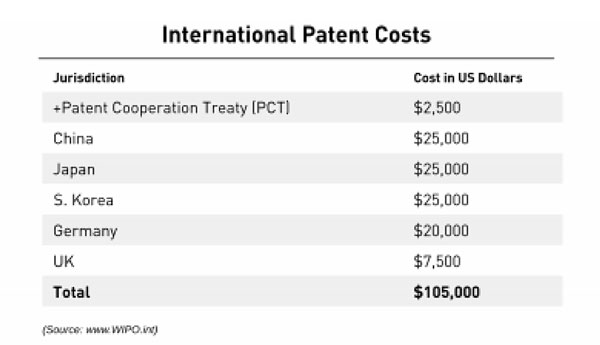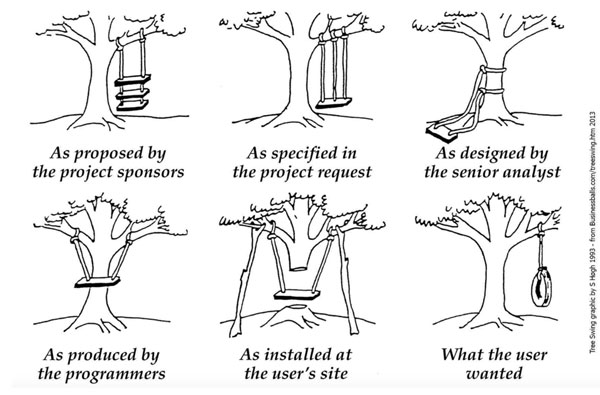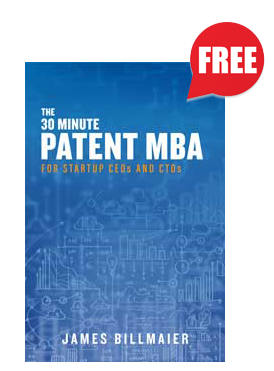This is #7 in our series of chapter excerpts from the book The 30 Minute Patent MBA by TurboPatent CEO Jim Billmaier. Want to get the full ebook for free? Grab it here.
What About Filing For Protection in Countries Outside The U.S.?
Without going into too much detail, it’s safe to say that international patent filings are expensive and time-consuming.
Below is a simple timeline of the process (note: not to scale) to give you a sense of how long a global patent filing typically takes:

The bottom line is that you have 12 months after filing for patent protection in the United States to file under the Patent Cooperation Treaty (PCT), which preserves your right to file in any of the 148 countries participating in the PCT.
The cost to file with the PCT is $2,500. However, the eventual cost of filing in the separate countries varies. Here is a list of the most important jurisdictions among the countries, which represent about 80% of all patent applications and grants worldwide.

Energy is a function of mass and speed. As a startup, your company enjoys neither the benefit of large piles of cash nor huge numbers of employees and other resources. But you can compensate for your lack of size by moving quickly to generate market energy. It’s also true that with the momentum that large companies achieve through their market successes brings inertia.
Your smaller company can more easily and quickly create and implement innovative solutions than can lumbering giants. I suspect that the above statements are not surprising, as it’s been long taught that smaller organizations have the ability to move faster, are less thought-constrained, and can implement more quickly than large, established corporations.
What may come as a surprise is that early-stage companies also have the ability to protect their inventions faster, cheaper, and better than large organizations.
Faster: In most of the world, including the United States, the first inventor to file an application for an invention is the owner of that invention. Large corporations have long invention discovery, disclosure, and approval processes. And once approved for drafting, the bespoke approaches they employ to draft and file a patent application usually take months.
In a typical large company, it’s very common for six months or more to pass from the point an inventive concept is uncovered to the point of filing with the USPTO.
Using the Inventioneering approach of combining the discovery of your company’s invention immediately upon the creation of the product with the use of automated invention protection (AIP), an early-stage company can go from invention discovery to filing in a month or less. But you must not hesitate, as your time advantage will evaporate quickly.
Cheaper: The United States Patent Office gives “small entities” (companies with fewer than 500 employees) a 50% discount on fees associated with filing and prosecuting a patent. Additionally, large companies tend to be encumbered by legacy relationships with inefficient, high-overhead law firms. Both large companies and the patent firms they use are slow to adopt automation technology that reduces cost.
The high costs surrounding the traditional patenting process is what most often causes CEOs of a startup companies to hesitate. He or she is often faced with the false choice of “Do I spend my limited capital on building the product or do I address the legalities of protecting my crown jewels”?
Luckily, there are new ways to reduce the drafting and prosecution costs without sacrificing quality. In fact, the quality inherent in these options will more than likely be superior. Combining the patent process with engineering, an approach that includes automation and analytic technologies, can reduce your overall costs by 50% or more. This is true for two reasons:
First, the automation tools allow the patent professional to create high quality patent documents in a fraction of the time as compared to traditional methods. Second, the engineering approach uses huge data sets to analyze and deliver documents that flow more easily through the examination process. “Greasing the skids” at the USPTO decreases the time and energy required to obtain a granted patent, thereby significantly decreasing the cost.
Better: Being able to execute faster and cheaper than a large organization can is a straightforward and obvious advantage. Understanding how and why your organization can obtain better IP requires two things: first, you should know how dysfunctional the patent process often is in large organizations, and second, you need to learn how NOT to let your organization fall into traps that result from those dysfunctions.
A large company will have a portfolio containing thousands of patents. IBM, for example, maintains about 40,000 U.S. patents; the company plays a quantity game. It’s an outdated strategy but large organizations change very slowly. In fact, it’s likely that the vast majority of many companies’ patents are invalid, unenforceable, or worthless for other reasons. This occurs because a large company’s dedicated patent organization is focused on filing and “successfully” prosecuting a specific number of patents every year. The engineers, scientists, and other inventors usually do not share that goal.
The result is that the inventors do not deeply engage in the process. As a result, the invention that is prosecuted to allowance by the USPTO does not do a great job of faithfully representing an inventor’s often brilliant idea.
Remember the game of telephone, where each time a message was transmitted to another person it degraded to the point where it became unrecognizable? Or the famous cartoon of a tree swing design that depicts the contrast between what the customer wanted and the ridiculously complex results delivered.
Well, in large companies—and too often in smaller companies as well—this is what happens during the patent process.

This has been an excerpt from the book The 30 Minute Patent MBA by Jim Billmaier. Used by permission of the author. Want to get the full ebook for free? Grab it here.





